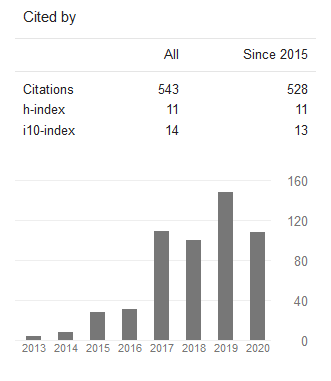Pengembangan Website Multi-Screen dan Analisis Perbandingan User Behaviournya
DOI:
https://doi.org/10.24002/jbi.v7i4.769Abstract
Abstract.
The wide availability of affordable smartphone and tablet in the market leads to the increase of internet access using mobile devices. Some users have started to leave desktop devices and are now using mobile devices. Some decide to use mobile device, some are still using desktop device, while some others are using both. This study aims to analyze the differences in the users’ behaviours when visiting a website in a desktop and mobile version. The aspects of the user behaviour studied are page view/visit, time on site, bounce rate, and registration ratio. The data are taken and saved by Google Analytics and database website which are analyzed by using descriptive statistic and ANOVA. The result shows that the desktop version has high value in those previously mentioned aspects compared to the mobile version.
Keywords: User Behaviour, desktop, mobile, analytics.
Abstrak.
Membanjirnya smartphone dan tablet di pasaran dengan harga terjangkau, mendorong naiknya pengaksesan internet menggunakan mobile device. Sebagian user telah berpindah dari pengguna desktop device menjadi pengguna mobile device. Sebagian masih tetap menggunakan desktop device, dan sebagian lagi menggunakan keduanya. Tujuan dari penelitian ini adalah mengembangkan website multi-screen dan menganalisis perbedaan user behaviour ketika mengunjungi website versi desktop dan versi mobile. Adapun user behaviour yang diteliti adalah: pageview/visit (banyaknya halaman yang dibuka user tiap berkunjung), time on site (durasi kunjungan user), bounce rate (rasio user yang hanya membuka satu halaman kemudian meninggalkan website), dan registration ratio (rasio user yang bersedia mendaftar). Data diambil dan disimpan oleh Google Analytic dan database internal website, yang kemudian dianalisis menggunakan statistik deskriptif dan ANOVA. Hasilnya menunjukkan bahwa semua jenis user behaviour website versi desktop dan versi mobile yang diteliti mempunyai perbedaan yang signifikan.
Kata Kunci: User behaviour, desktop, mobile, analytics.
References
Barros, A. C., Leitão, R., & Ribeiro, J. (2014). Design and Evaluation of A Mobile User Interface for Older Adults: Navigation, Interaction and Visual Design Recommendations. Procedia Computer Science, 27: 369-378.
Hancock, R. (2008). The Complexities of Developing Accessible Web Content for Mobile Devices. Multimedia and E-Content Trends: 111-116).
Hung, W. H., & ChanLin, L. J. (2015). Development of Mobile Web for the Library. ProcediaSocial and Behavioral Sciences, 197: 259-264.
Johnson, T., & Seeling, P. (2014). Desktop and Mobile Web Page Comparison: Characteristics, Trends, and Implications. Communications Magazine, IEEE, 52 (9): 144-151.
Lalji, Z., & Good, J. (2008). Designing New Technologies for Illiterate Populations: A Study in Mobile Phone Interface Design. Interacting with Computers, 20 (6): 574-586.
Lobaziewicz, M. (2015). The Design of B2B System User Interface for Mobile Systems. Procedia Computer Science, 65: 1124-1133.
Mulyani, Sri. (2007). Peranan Metode Pengembangan System Development Life Cycle (SDLC) terhadap Kualitas Sistem Informasi. Jurnal Ekonomi dan Bisnis Terapan, 3 (2).
Nylander, S. (2009). Online Behaviour from Desktop and Mobile Devices are Connected, CHI, Boston, Amerika Serikat.
Plaza, B. (2011). Google Analytics for Measuring Website Performance. Tourism Management, 32(3): 477-481.
Prasetio, A., & Hatammimi, J. (2013). The Potential Customer Duration/Visit Characteristic Based on Traffic Source in a Service Provider Web Site. Jurnal Aplikasi Manajemen, 11 (1). PUSKAKOM. (2014). Profil Pengguna Internet Indonesia 2014, (Online), (http://www.apjii.or.id/v2/read/article/apjii-at-media/777/apjii-penguna-internet-diindonesia-2014.html, diakses 11 April 2015).
Puspitasari, L., & Ishii, K. (2016). Digital Divides and Mobile Internet in Indonesia: Impact of Smartphones. Telematics and Informatics, 33 (2): 472-483.
Roudaki, A., Kong, J., & Yu, N. (2015). A Classification of Web Browsing on Mobile Devices. Journal of Visual Languages & Computing, 26: 82-98.
Rouse, M. (2015). Definition: User Behavior Analytics (UBA), (Online), (http://searchsecurity.techtarget.com/definition/user-behavior-analytics-UBA, diakses 3 Maret 2015).
Wong, C. Y., Khong, C. W., & Chu, K. (2012). Interface Design Practice and Education Towards Mobile Apps Development. Procedia-Social and Behavioral Sciences, 51: 698-702.
Yu, N., & Kong, J. (2016). User Experience with Web Browsing on Small Screens: Experimental Investigations of Mobile-page Interface Design and Homepage Design for News Websites. Information Sciences, 330: 427–443.
Downloads
Published
Issue
Section
License
Copyright of this journal is assigned to Jurnal Buana Informatika as the journal publisher by the knowledge of author, whilst the moral right of the publication belongs to author. Every printed and electronic publications are open access for educational purposes, research, and library. The editorial board is not responsible for copyright violation to the other than them aims mentioned before. The reproduction of any part of this journal (printed or online) will be allowed only with a written permission from Jurnal Buana Informatika.
This work is licensed under a Creative Commons Attribution-ShareAlike 4.0 International License.









